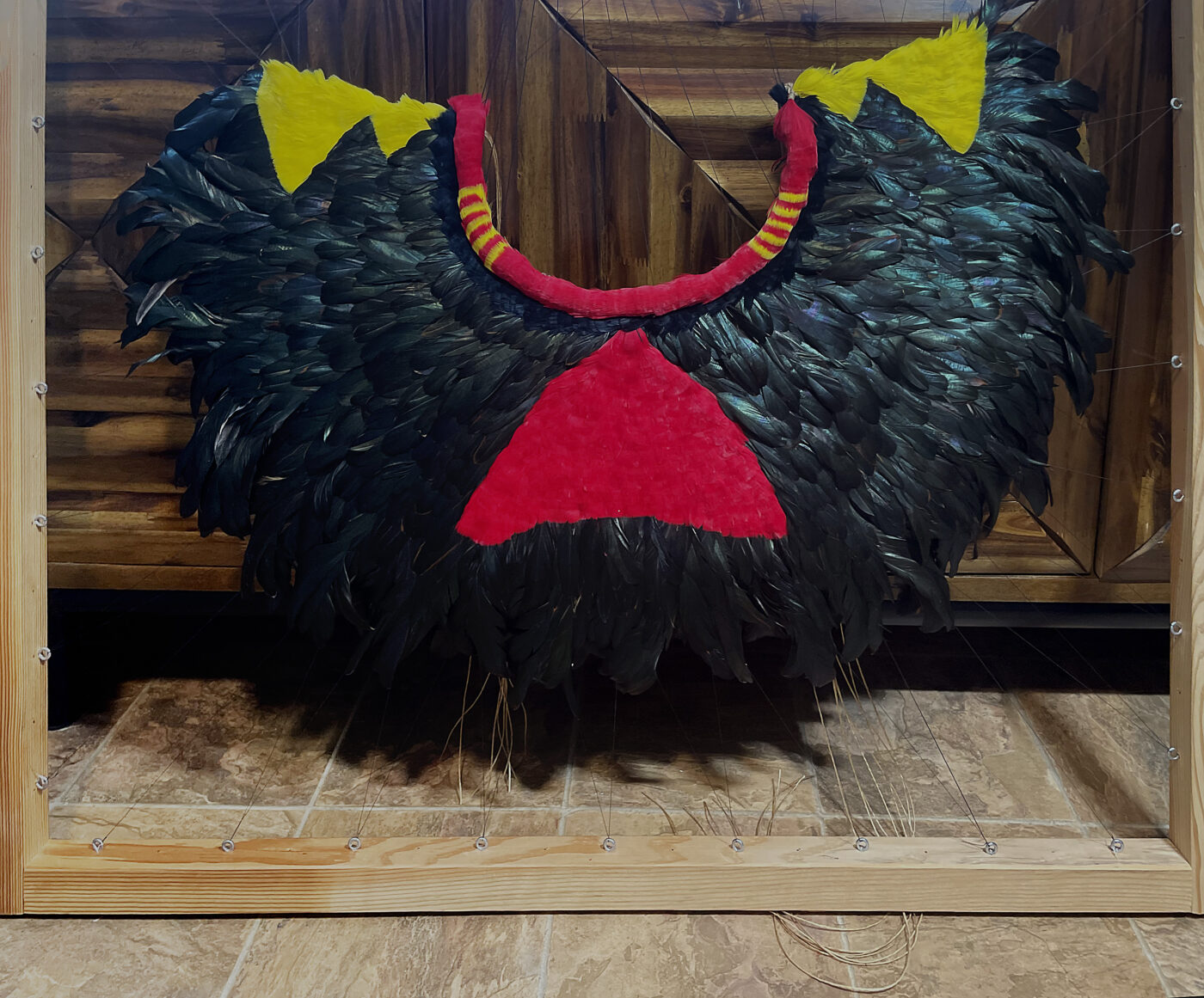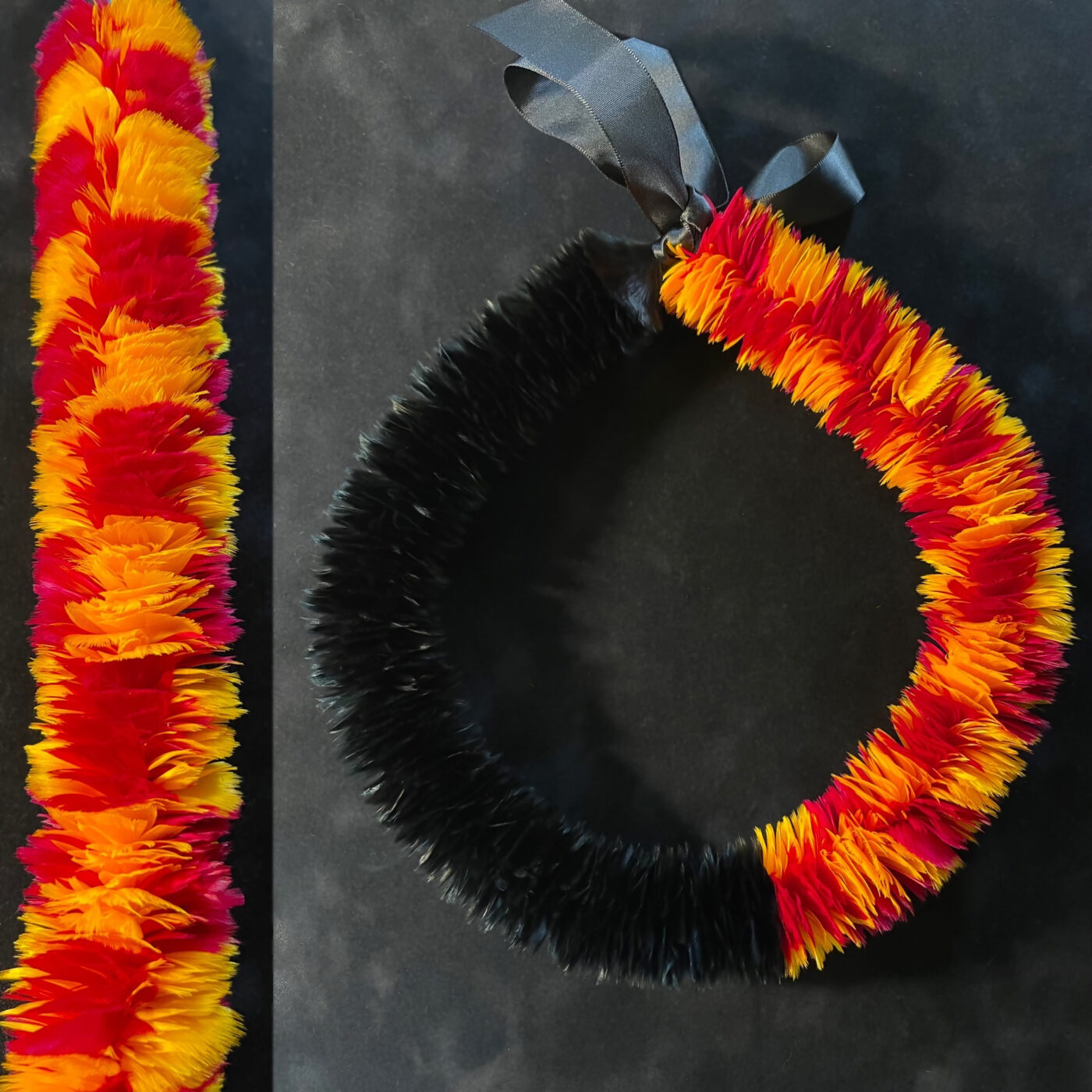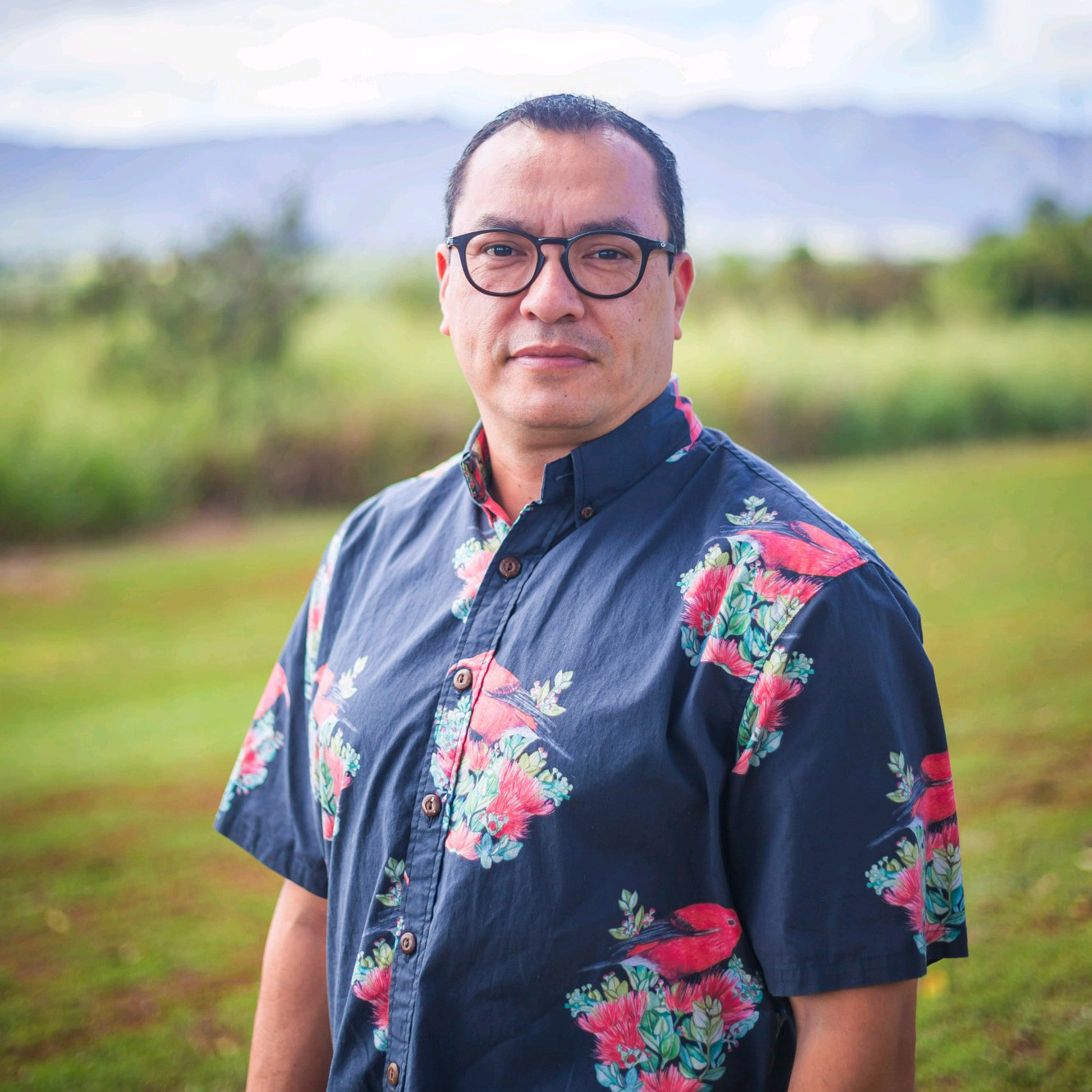u
l
e
a
n
a

“There is nothing new under the sun, but there are new suns.” –Octavia Butler

4–5 minute experience, or the time it takes to steep a cup of tea.
Hulu (Hawaiian featherwork) artist Kawika Lum-Nelmida creates adornments that are imbued with traces of the past, present, and future. Carrying forward the use of feathers to protect wearers, Lum-Nelmida researches historic objects, studies patterns he finds in the surrounding environment, and incorporates the intentions of the wearer with each piece. In the following reflection, Lum-Nelmida shares how he learned to make hulu, what it signifies, and expresses hope that future generations continue to uphold this important practice.
BY KAWIKA LUM-NELMIDA
Hawaiian featherwork is the processing of feathers gathered from native birds into adornments for our aliʻi (royalty, ruling class). Traditionally, feathers were gathered when the bird would molt, and no harm would come to the bird. Today, native Hawaiian birds are endangered or extinct and the use of their feathers are restricted; therefore, in my practice, I do not collect feathers from birds to create art. Hawaiian featherwork had to adapt by using non-native bird species that are sustainable. The common feathers that I now work with come from roosters, geese, ducks, peacocks, and pheasants.

[ID: A cape made of black feathers displayed on a wooden frame so that the back faces out and the edges hang at the top. A large red triangle points up to the neck, which is made of red feathers with thin yellow stripes. Yellow triangles line the edges.]
Native Hawaiians believe that birds have the ability to travel between the different levels of the heavens, forest, land, and sea. This in turn gives them a perspective that humans don’t have.
The use of feathers for adornments have a spiritual significance. Native Hawaiians believe that birds have the ability to travel between the different levels of the heavens, forest, land, and sea. This in turn gives them a perspective that humans don’t have. The feathers protect the wearer of the adornment, or the space that an adornment may occupy. Traditionally, featherwork was worn over the spiritual entry points of the body to protect the wearer during times of war, religious ceremony, or significant occasions.
In 1997 at the University of Hawaiʻi at Mānoa, I was fortunate enough to take a lei hulu (feather lei) workshop taught by master teacher Paullette Kahalepuna. After taking this workshop I continued to study with her, and she taught me all aspects of Hawaiian featherwork. She also taught me that in order to move forward, we need to look back at the work that our kūpuna (ancestors) did. This required going into museum collections to study their featherwork, and training me to look at objects in a very different way.
Upon examining a historic feather object, I am able to discern the technical skills that were needed to create those pieces, but I have no context on the pattern, design, and significance of the object. The knowledge of pattern and design was passed from kumu (master teacher) to haumana (student). My creative process of designing patterns comes from my learning of many cultural practices. Studying hula (traditional Hawaiian dance), netting, cordage, and environmental systems, among other subjects, has influenced the creation of my featherwork. The combined knowledge of these practices helps me understand what my ancestors might have been thinking when creating. I draw inspiration from the natural environment — plants, animals, and elements — as well as the relationships between designs and the environment.
[ID: Lei Kamoe Education Award: A bright yellow lei tied with shiny black ribbon. A design of black surrounded by red stripes takes up a large part of the left side of the lei. A centerpiece of white and brown feathers rests on the black. Lei Kamoe Lori Pourier: A lei with small yellow feathers and circular green feathers floating on the background of smooth red feathers, tied with a shiny black ribbon. Lei Kamoe East West: A lei made with smooth blue feathers with a highlight of curved yellow feathers at one side. The ends are tied together with shiny black ribbon.]
The creation of featherwork also requires me to delve into the spiritual significance of the adornment for the wearer. Each piece is created to express the intentions of the wearer. Feather patterns, colors, and pattern placement on the wearer’s body have different meanings. The creation of geometric designs, lines, and patterns connect the adornment to the individual or occasion. This helps to hold the object in a specific place and time; consequently, these objects hold memories.
Feather patterns, colors, and pattern placement on the wearer’s body have different meanings. The creation of geometric designs, lines, and patterns connect the adornment to the individual or occasion. This helps to hold the object in a specific place and time; consequently, these objects hold memories.
As mentioned previously, featherwork was traditionally reserved for the aliʻi, and is revered by native Hawaiians. Historically, our aliʻi would gift feather lei (garlands) and feather cloaks to dignitaries when visiting abroad; hence, to be given a featherwork is the highest way to honor an individual. Nowadays featherwork is created for everybody and for all significant occasions: graduations, honorings, birthdays, and promotions. The use of featherwork for these events all have a common link: to mark a moment in time with an heirloom piece and hold with it the memories of the occasion.

[ID: A lei made of patterned, textured feathers, half black, half checkered gold and red, and tied with a blue ribbon. Next to the lei is a close-up of the colored pattern, revealing the intricate layering of feathers.]
With new and modern times comes the need to ensure the continuity of the practice, and preservation of the ancestral knowledge in its most unadulterated form. We need to ensure that the next generation is able to use the techniques and skills learned to create modern pieces. In my opinion, as long as the next generation is knowledgeable in the traditional techniques, forms, and teachings, we will be able to ensure the longevity of our cultural practice. As long as the next generation is able to create, we can ensure the longevity of our people.

[ID: Kawika stands against the Ewa/Waipio plains on Oʻahu. He is wearing a ʻIʻiwi aloha shirt and dark glasses.]
Kawika Lum-Nelmida
He // Him // His
Wahiawa, HI
Kawika Lum-Nelmida, is a hulu (feather) artist from Pūpūkea, Oʻahu. Lum-Nelmida started learning about hulu from Paulette Kahalepuna in 1997 at the University of Hawaiʻi at Mānoa. While at the University of Hawaiʻi, he studied Natural Environment and Fiber Arts within the Hawaiian Studies program and graduated with a Bachelors of Arts in 2001. His fiber arts teacher at the university was master artist Maile Andrade. He has been an active artist participant in MAMo, Maoli Arts Movement since 2012, and in 2013 he was awarded a Master’s Apprenticeship through the Hawaiʻi State Foundation in the Culture and the Arts with Paulette Kahalepuna. Under this apprenticeship, Lum-Nelmida studied Hawaiian featherwork in the forms of lei (adornment), kāhili (feather standard), ʻahuʻula (cape), and mahiʻole (helmets). He also studied works from traditional materials, and learned how to use, cultivate, and preserve them. He uses modern materials with traditional practices to create contemporary art pieces. He recently ventured into clothing design and is now an artist in the annual MAMo Wearable Art Show. In 2021, Lum-Nelmida was awarded the United States Artists Fellowship.
